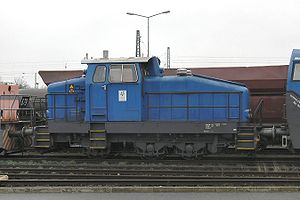Henschel DHG 500 C
| Henschel DHG 500 C | |
|---|---|
|
Henschel DHG 500 C as locomotive 1 of Sasol in Moers
|
|
| Number: | 62 |
| Manufacturer: | Henschel |
| Year of construction (s): | 1963-1976 |
| Axis formula : | C. |
| Gauge : | 1435 mm ( standard gauge ) |
| Length over buffers: | 9,900 mm |
| Fixed wheelbase: | 3,700 mm |
| Smallest bef. Radius: | 80 m |
| Top speed: | 30 km / h / 50 km / h |
| Installed capacity: | 368 kW (500 hp) |
| Motor type: | Henschel 12V 1416 |
| Power transmission: | hydraulic |
The Henschel DHG 500 C is a diesel-hydraulic locomotive that was built by the Henschel works . It was intended primarily for use in heavy factory service.
Technical details
The wheel arrangement of the Henschel DHG 500 C is C. The locomotive belongs to the so-called fourth generation of Henschel locomotives offered from 1962/63, the first generation with cardan shaft drive. The superstructures were adopted from the previous generation without any major changes. For use in hazardous areas, the locomotive was in an explosion-proof available variant. With the same external dimensions and a modified engine version, it was built as the DHG 440 C (two locomotives) and DHG 700 C (20 locomotives).
The locomotives could be ordered with a reversing gearbox, which could then be switched while driving. The multi-step transmission can process two speed levels, 30 km / h and 50 km / h can be set. The central axis was laterally displaceable for better arc movement. The engine was supercharged to increase performance .
The Henschel DHG 500 C was built between 1963 and 1976 in 62 copies, six of them with explosion protection. The locomotives mainly went to mining companies and steel producers as well as chemical companies. For example, Rheinelbe Bergbau AG in Gelsenkirchen acquired eleven locomotives and Hibernia AG , Zechenbahn- und Hafenbetriebe Ruhr-Mitte in Gladbeck, nine DHG 500 C locomotives. Most of the locomotives had the Henschel standard paintwork in blue with two horizontal decorative stripes on delivery Stems on. The Ruhrkohle AG, created through the merger, temporarily had 31 locomotives of this type in stock. The VW works had bought three locomotives that were still in use in 2012. Opel has four locomotives, which are initially stationed in Bochum and since 2015 in Rüsselsheim. These locomotives had no leaf springs and were delivered with mega-springs and shock absorbers.
Whereabouts
- At today's mining railway operator RBH Logistics GmbH in Gladbeck, a locomotive with the road number 440 was still in use until September 2017. After her last deadline she was parked at the last Ruhrzeche Prosper Haniel in Bottrop. At the beginning of 2019 it was saved from scrapping and is preserved as a museum. It is the first DHG 500 C ever built.
- The locomotive with the serial number 30858 was delivered to Rheinstahl in 1965 and has been in Switzerland since 1987. It bears the road number Em 837 825.
- The 31111 locomotive, which was delivered to STEAG in 1965, has been in Switzerland since 1994. It had belonged to the Solothurn-Niederbipp-Bahn since 1997 and later its successor Aare Seeland mobil and was given the road number Em 837 826.
- Another machine is in the holdings of the Austrian Society for Railway History and occasionally carries out shunting work at its base in Ampflwang .
literature
- Helmut Petrovitsch: Kassler classics for industrial railways. In: railway magazine. 4/2012, pp. 6-15.
Web links
- Henschel DHG 500 C at rangierdiesel.de
Individual evidence
- ^ CV of Henschel 30858 at rangierdiesel.de, accessed on August 24, 2014.
- ↑ resume the Henschel 31111 at rangierdiesel.de, accessed on August 24, 2014.


